Spring is perhaps the best time to plan a visit to one of America’s national parks. Staying ahead of the crowds that bustle through these natural jewels from June to September gives you more time to enjoy their natural beauty relatively undisturbed. There’s a lot going on, from super blooms to supermoons, as spring wakes up the plants and animals that call these places home. Here are the best national parks to visit this spring.
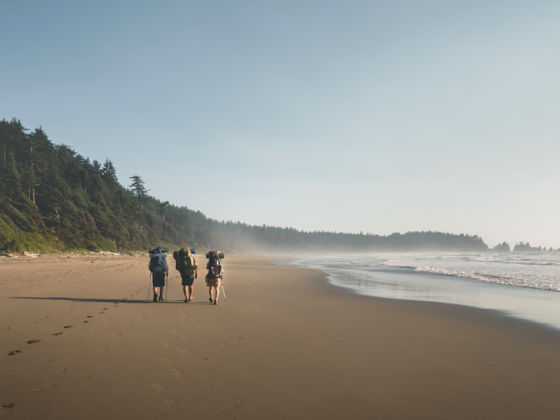
The Best National Parks to Visit This Spring
Saguaro National Park, Arizona
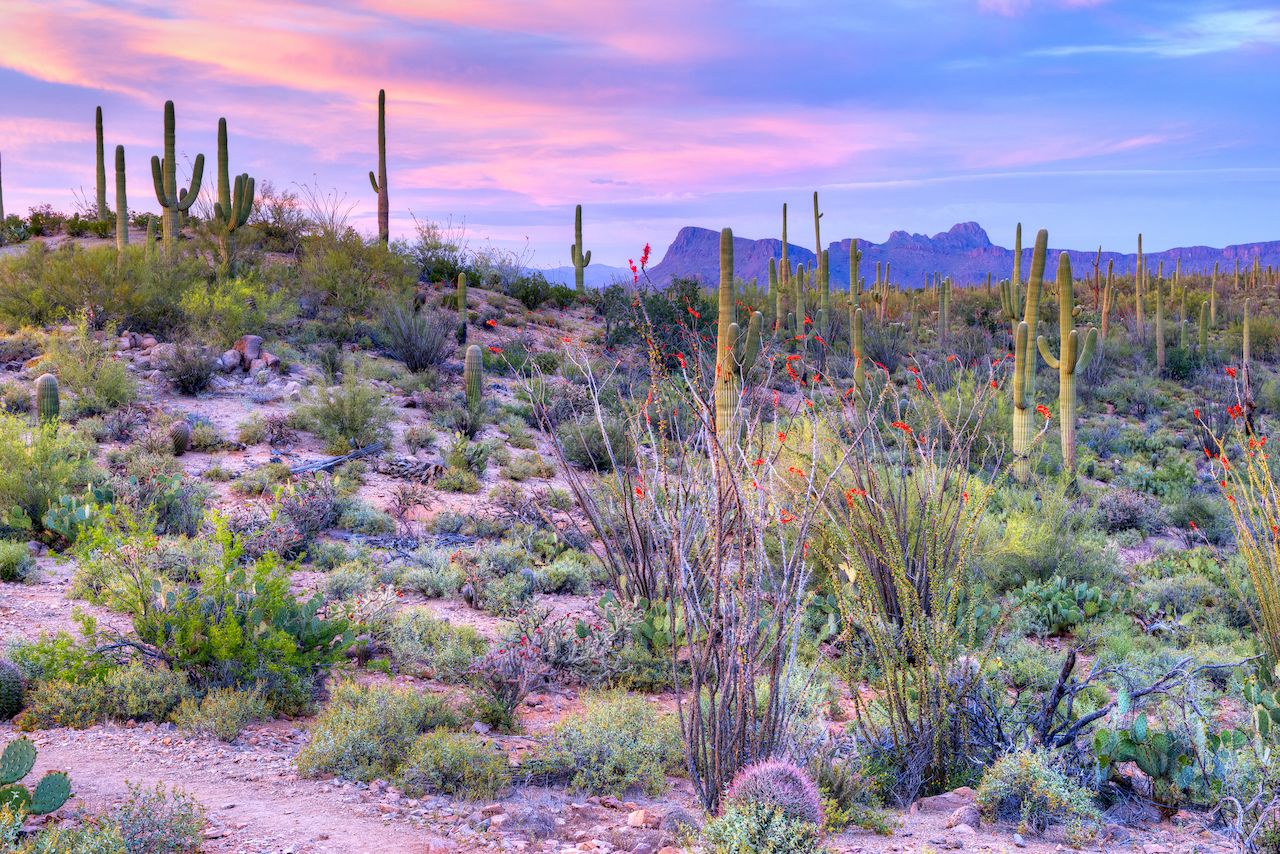
Photo: Anton Foltin/Shutterstock
It’s not the crowds that visitors to Arizona’s Saguaro National Park have to battle. It’s the heat. That makes spring the ideal season to experience the so-called symbol of the American West, the giant saguaro cactus. Saguaro cacti are found only in a small portion of the United States, yet here they stand, an estimated 1.8 million of them in vast sentry to the desert.
These curious plants are precious because they take so long to grow, with branches normally beginning to appear only after a saguaro reaches 60-75 years of age. In some places these “arms” can take more than 100 years to grow. An adult saguaro is considered to be 125 years old, may weigh as much as eight tons and be as tall as 50 feet. At about 35 years of age, saguaro begin to produce creamy, white flowers, which open at night and close the following afternoon. The flowers bloom from late April to early June.
There are two districts of Saguaro National Park, to the east and west of Tucson. Between the two there are over 165 miles of hiking trails, from short interpretative trails and petroglyph trails to day-long wilderness treks. Aside from hiking, photography is obviously a favorite pastime in the park, along with backcountry camping and wildlife watching — including birds, javelinas, desert tortoise, and for the very lucky, a rare Gila monster.
No lodging is available nor is vehicle camping permitted in the park, so look to Tucson for places to stay. If you plan to camp, you’ll need to backpack into the campsites and bring your own water as none is available in the park.
Isle Royale National Park, Michigan

Photo: Mark Baldwin/Shutterstock
Among the more original of national parks, Isle Royale in Michigan is actually an archipelago consisting of over 400 islands isolated from civilization by the vast waters of Lake Superior. Extreme weather forces this park to close for five to six months per year, but for lucky spring travelers, it opens on April 16.
Being that the park is mostly water, boating is the best way to experience Isle Royale’s particular beauty. Private boat owners (or renters) will find countless docks and anchor buoys from which to venture forth. Ferries also serve different parts of the park, and you can choose from numerous guided boat tours. Canoeing, kayaking, fishing, hiking, and camping are the most popular activities here. Even scuba divers might find a little bit of paradise exploring one of the park’s 25 shipwrecks, provided they’re equipped with dry suits for spring’s chilly water temperatures.
Specific to this park are its highly studied wolf and moose populations. Because of its remoteness, the archipelago has been populated by just about one-third of the usual mainland mammals, not including apex predators like bears, which would normally compete for food with wolves and moose. Unfortunately, due to inbreeding, the park’s wolf population, usually numbering around 25 individuals, has been decimated and consists of just one female. The National Park Service is currently implementing a plan to relocate 20-30 wolves to the park. As for the moose, it’s hard to miss one. Their numbers change season to season but are usually around 1,000. Obviously, hunting is prohibited within the park.
The park is remote, but there are two developed areas, Windigo and Rock Harbor. Ferries dock in both towns, and each offers stores, restaurants, showers, campsites, and cabins. Three dozen designated wilderness campgrounds are scattered throughout the islands, some of which are accessible by hiking trail and others only by canoe, kayak, or private boat. Be prepared for solitude and also for backcountry roughing it as campfires are not permitted at most campgrounds. You’ll also have to pack in your own water or draw it from local water sources and filter, treat, or boil it to avoid parasites.
Olympic National Park, Washington

Photo: kan_khampanya/Shutterstock
Nearly one million acres of wilderness beckon many to this lush park on Washington State’s remote Olympic peninsula. In 1976, Olympic National Park was designated by UNESCO as an International Biosphere Reserve, and in 1981, it became a World Heritage site. Here, one can experience storms on the wild Pacific coast, glaciers on craggy mountaintops, and behold the beauty of moss-covered old-growth trees in the temperate Hoh and Quinault rainforests.
Multi-day beach hiking trips are possible, and popular, along the miles of coast in Olympic National Park as camping is permitted on the beach. Campers must choose sites beyond high tide marks to ensure they, and their gear, aren’t swept away. Spring is an ideal time for tidepooling and kayaking, as well as watching for grey and humpback whales making their way north to Alaska from their wintering grounds in Mexico. Backcountry hiking and camping are also popular in the park as few roads run far into its interior.
The rainforests here are among the wettest areas in the continental US, making an extended trip into their verdant vastness an unforgettable experience. Along with some of the tallest trees in the US, hikers are treated to lush carpets of bright green moss and massive ferns. Dependant on snowpack, a hike or drive to Hurricane Ridge, atop the Olympic mountain range, puts one in view of glaciers. Sightings of black bear, elk, and mountain goats are also possible.
The park has 16 campgrounds, some with yurts or cabins, and also lodges. If you prefer creature comforts, Lake Crescent Lodge and Sol Doc Hot Springs Resort are scenic options.
Mammoth Cave National Park, Kentucky

Photo: Wangkun Jia/Shutterstock
Before the summer swelter and barrage of seasonal bugs hit the South, temperate spring weather beckons visitors to the rolling green hills of south central Kentucky. Here, Mammoth Cave National Park preserves the world’s longest known cave system. With more than 400 miles of surveyed passages, it’s nearly twice as long as Mexico’s Sac Actun underwater cave and its well-known string of jewel-toned cenotes.
As the name suggests, Mammoth Cave is the main attraction here, and the National Park Service offers a variety of cave tours to visitors. Among the most notable features are “Frozen Niagara,” a waterfall-like cascade of mineral deposits and the tight squeeze of “Fat Man’s Misery.” You can’t explore the cave on your own, and tours of the cave’s many features are extremely popular — so call ahead for reservations. Note there are some access restrictions in the caves: No strollers or child backpack carriers, camera tripods, and some places may not be accessible to those who have trouble walking
This being Kentucky, horseback riding is popular in the park, and there are 60 miles of trail dedicated to horses with commercial tours also available. Hiking is also a favorite pastime, with nearly 84 miles of back and front country trails. Fishing is allowed on over 30 combined miles of the Green and Nolin rivers, which meander through the park, offering anglers their chance at scoring bluegill, catfish, bass, perch, and other game fish. Canoeing and kayaking are particularly nice ways to enjoy the beauty of the area.
The park has a small, rustic lodge; three developed campgrounds; and more than a dozen primitive backcountry camping sites. If you don’t want to rough it, head to nearby Bowling Green, where you’ll find options for lodging, food, and a taste of the state’s famed Kentucky bourbons.
Acadia National Park, Maine
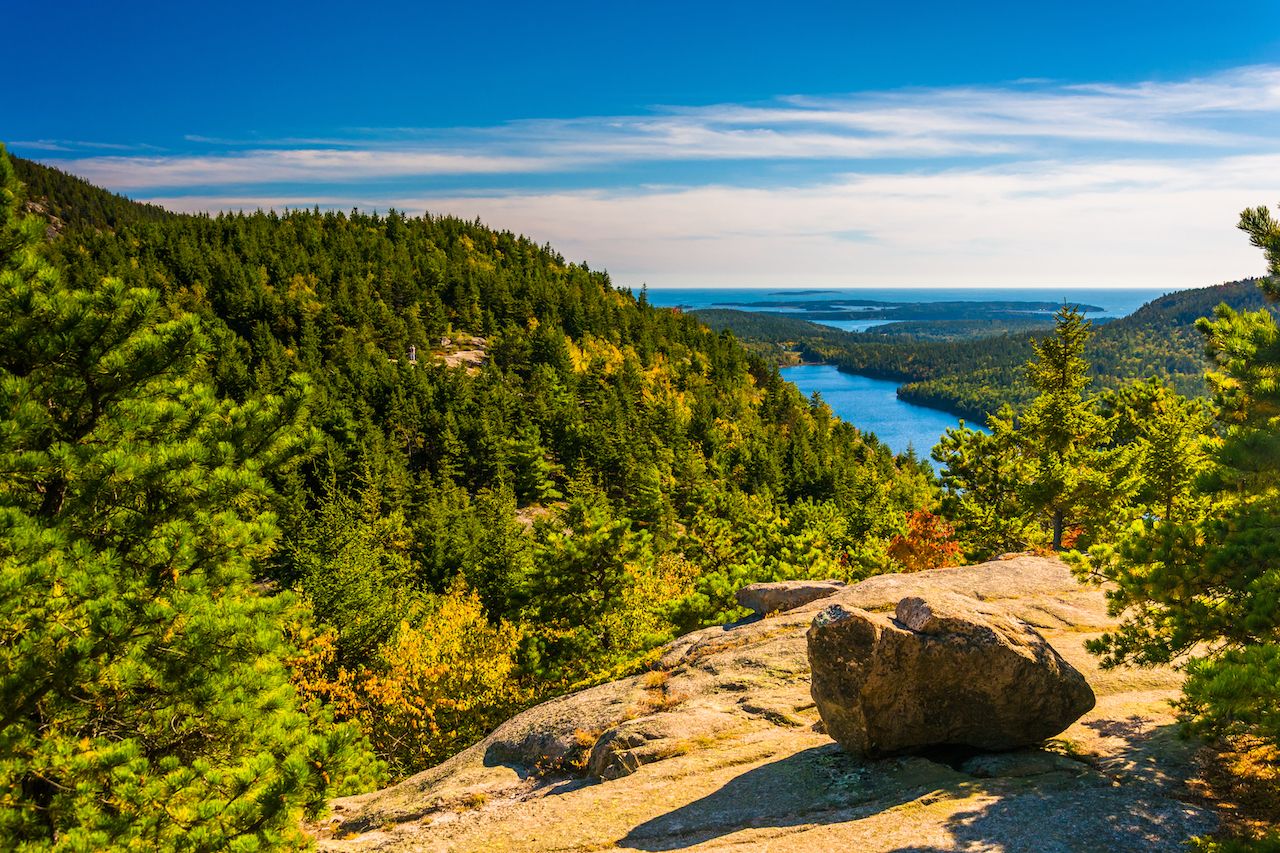
Photo: Jon Bilous/Shutterstock
The ideal time to visit the Maine park sometimes called “a photographer’s dream” is spring — ahead of the majority of its 3.5 million annual visitors. Just under 50,000 acres, Acadia National Park preserves mountains, woodlands, lakes, ponds, and coastline of Mount Desert Island — almost half the area of the island. Atop Cadillac Mountain, the tallest mountain on the eastern coastline, visitors can be among the first in the US to watch the sunrise.
A full 158 miles of hiking and biking trails allow you to explore the island’s interior sights, which include seven mountain peaks over 1,000 feet, old stone bridges, and carriage roads. Here, you might glimpse of some of the dozens of mammal species that call the park home, including black bears, moose, and deer. Bird watching is popular in the park, as over 300 bird species have been catalogued here — the most famous being peregrine falcons. Because of their once-endangered status, recovery efforts are taken seriously, and some trails may be closed in spring to avoid disturbing nesting falcon families.
Boating, tidepooling, and fishing are also great ways to experience this coastal park. You’ll need reservations for ranger-guided boat tours, and you should also reserve camping spots. Bar Harbor, a half-mile from the park entrance, also has lodging and dining options.
Mesa Verde National Park, Colorado
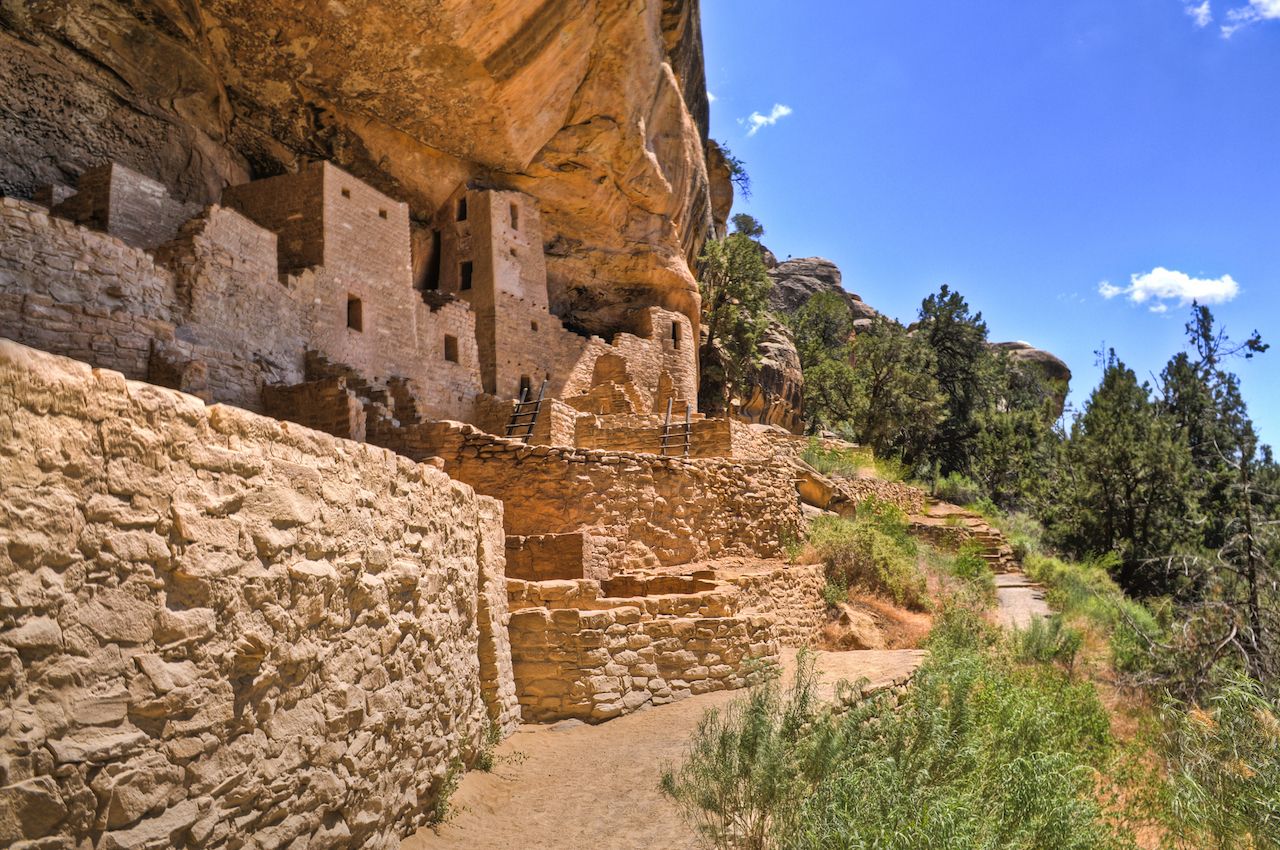
Photo: Kris Wiktor/Shutterstock
Established in 1906, Mesa Verde National Park preserves the archeological heritage of the ancestral Pueblo people that made its cliffs and mesa tops their homes from 600 to 1300 AD. The Colorado park has some of the best-preserved cliff dwellings in the US — over 600 of them, along with more than 5,000 archaeological sites.
Hiking is limited in the park, given the number of archaeological sites, so you should plan to view the majority of the park’s highlights by car. There are over 40 miles of roads with viewpoints of cliff dwellings, as well as interpretive stops at archaeological sites. You can join a guided ranger hike into the cliff dwellings, but tickets sell out almost immediately — so arrive early to reserve a spot. Tours to these impressive structures can be strenuous and involve hiking, climbing ladders, and crawling through tight areas. Long House, Balcony House, and Cliff Palace, the park’s largest cliff dwelling, are all currently open to visitors on tours.
The park’s Morefield campground is open only with limited resources until April 18, when full services become available for all 267 sites. Far View Lodge opens April 11, and there are also plenty of options for lodging and food in the funky nearby town of Cortez, Colorado.
Badlands National Park, South Dakota
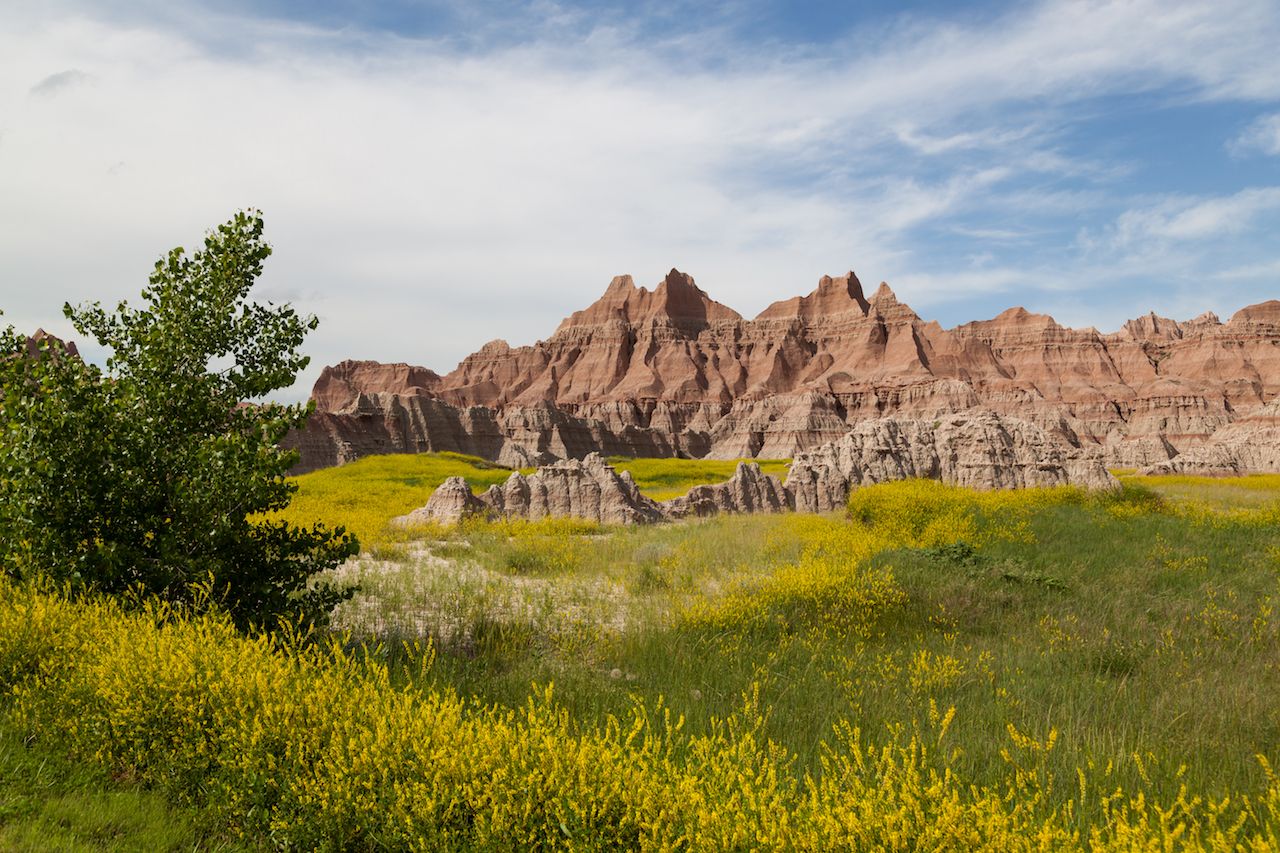
Photo: Tami Freed/Shutterstock
“The Badlands” is an area known around the world for its striking geography of multi-colored buttes and pinnacles rising from one of the world’s richest fossil beds. While marine fossils are common, this area in South Dakota has also produced the preserved remains of exotic creatures ranging from camels and three-toed horses to rhinoceroses and saber-toothed cats.
Badlands National Park’s 244,000 acres also protect the country’s largest undisturbed mixed-grass prairie, through which bison, bighorn sheep, prairie dogs, and black-footed ferrets roam today. The area is also home to the Oglala Lakota Sioux, the native people of the area, who co-manage the park’s south unit.
The weather doesn’t permit the full opening of the park until warmer months. The Ben Reifel Visitor Center is open year-round to welcome guests and provide interpretation and guidance to the park’s sights. While the center does house a fossil preparation lab, this does not open until June when the weather allows archaeologists to dig. During this time of lowered crowds, you can take advantage of the relative quiet to explore the park by bicycle on the Badlands loop road or off-road on loop trail rides that span up to 27 miles.
If you have the gear, consider backcountry camping among herds of bison and the ravines and pinnacles that 19th-century French trappers called ”mauvaises terres a traverser,” or “bad lands to travel across.” Note: There is no water available in the park outside of the main visitor center so bring your own.
The independently operated Cedar Pass Lodge and campgrounds opens April 20 and takes advance reservations, which are recommended.
Redwood National Park, California

Photo: mywp/Shutterstock
Most people know Redwood National Park as home to the tallest trees on Earth, but as part of a complex of adjoining state parks, it’s also home to beaches and pristine rivers. Redwood National Park, Del Norte Coast, Jedediah Smith, and Prairie Creek Redwoods state parks together protect 139,000 acres of wilderness, including almost half of all remaining old-growth coast redwood forests, 40 miles of coastline, and threatened species such as the northern spotted owl and Steller’s sea lion.
Redwood National Park was created in 1968, by which time nearly 90 percent of the original redwood trees had been logged. The parks’ remaining old-growth temperate rainforests are the stars of these parks — so camping, hiking, biking, horseback, and pack animal trips are its most popular pastimes for visitors. Coastal tidepooling is also a great option for spring visitors, and from April to early May, you might catch views of migrating grey and humpback whales.
While the state parks have car camping sites, hiking is the only way to reach the more remote campsites located on the federal sections. Towns on the north and south sides of the parks offer food and lodging. A fun side trip just inland of the parks is State Route 254, also called Avenue of the Giants, which takes drivers through a particularly scenic area of redwoods and includes sights such the 950-year-old Immortal Tree and the ever-popular Drive-Through Tree.